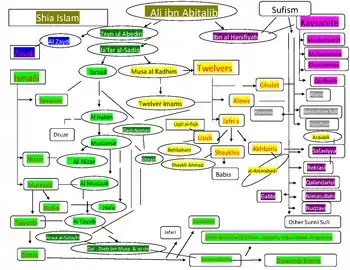Ghulat
Ghulāt (Arabic: غلاة, lit. 'exaggerators', 'extremists', singular ghālī غالي)[1] is used in the theology of orthodox Shia Islam and also by the Ahl as-Sunnah to describe some minority groups who either ascribe divine characteristics to figures of Islamic history (usually some members of the Ahl al-Bayt or any other significant figure in Islamic history, such as pious people, scholars and so on) or hold beliefs deemed deviant by mainstream, orthodox Sunni theology. In later periods, this term was used to describe Shia groups affiliated with the Zaydis, orthodox Twelvers (like the Rafidha) and sometimes the Isma'ilis who go to extremes in praise,[2] to the point of actively changing beliefs of the populace. A lot of times, this term is commonly used against extreme Shi'ites and ideological descendants of the Kharijites.
| Part of a series on Islam Shia Islam |
|---|
 |
|
|
The usage derives from the idea that the importance or the veneration of such a religious figure has been "exaggerated".
History

Traditionally, the first of the ghulāt was Abdullah ibn Saba', who may have denied that Ali had died and predicting his return (rajʿa), which was considered one form of ghuluww. According to M. G. S. Hodgson, the notion of the Occultation or absence of an Imam who is due to return as Mahdi seems to have appeared first among the ghulāt.[2] Other positions which seem to have been considered ghuluww by early writers were the (public) condemnation (sabb) of Abu Bakr and Umar as usurpers of Ali's right to be a successor of Muhammad, and the notion that the true Imams were infallible (maʿṣūm).[2]
In later periods, mainstream Shia groups, especially the Imamiyya,[1] have identified three acts that have been judged as "extremism" (ghuluww). These acts of heresy are: the claim that God sometimes takes abode in the bodies of the Imams (ḥulūl), the belief in metempsychosis (tanāsukh), and considering Islamic law to be not obligatory (ibāḥa), similar to antinomianism.[3]
For example, Alawites used to be considered ghulat by classical Shi'i scholars,[4]. For political purposes, in 1974 they were recognized through a fatwa released by Lebanese Shi'i cleric Musa as-Sadr as a current of Shiite Muslims.[5] However, the fatwa is binding only on the religious followers of as-Sadr, not all Shiites.
Grand Ayatollah Ali al-Sistani issued fatwa forbidding orthodox Shia Muslims from marrying Khawarij or ghulat sects “who claim to be Muslims, but are classified as non-Muslims.”[6]
References
- Ghulat at Encyclopædia Iranica
- Hodgson, M. G. S. (1965). "GHULĀT". Encyclopaedia of Islam. Vol. 2 (2nd ed.). Brill Academic Publishers. pp. 1093–1095.
- Heinz Halm (21 July 2004). Shi'ism. Edinburgh University Press. p. 154. ISBN 978-0-7486-1888-0.
- Matti Moosa (1987). Extremist Shiites: The Ghulat Sects. Syracuse University Press. pp. 256, 270. ISBN 978-0-8156-2411-0.
- The New Encyclopedia of Islam by Cyril Glasse, Altamira, 2001, p.36–7
- 2406. [...] There are certain sects like Khawarij, Ghulat and Nawasib who claim to be Muslims, but are classified as non-Muslims. Muslim men and women cannot contract permanent or temporary marriage with them. Source: https://www.al-islam.org/islamic-laws-sayyid-ali-hussaini-sistani/marriage-part-i-ii
Further reading
- Tucker, William Frederick (2008). Mahdis and millenarians: Shī'ite extremists in early Muslim Iraq. Cambridge University Press. ISBN 978-0-521-88384-9.
- Moosa, Matti (1987). Extremist Shiites: The Ghulat Sects. Syracuse University Press. ISBN 978-0-8156-2411-0.
- Halm, Heinz (1982). Die islamische Gnosis: Die extreme Schia und die ʻAlawiten. Artemis Verlag. ISBN 978-3-7608-4530-2.